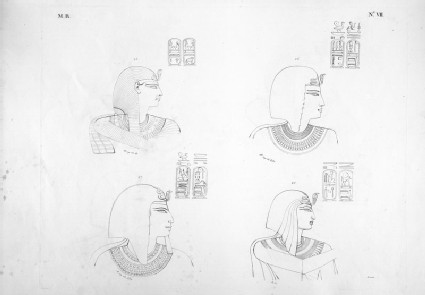Search Results: objects
Show search help© Sackler Library, courtesy of the Oxford Digital Library and University of Oxford Department of Oriental Studies "Digitization of Champollion and Rosellini" project
- Reference URL
Actions
Engraving of Portraits of the Pharaohs Merneptah, Sety II, Sethnakhte and Ramesses III from their Tombs at Biban el-Moluk Giuseppe Angelelli
-
Curator’s description:
Description
The print shows four heads and shoulders in profile, accompanied by identifying hieroglyphs in cartouches. They are numbered from top to bottom and from left to right, and depict: no. 25: Merneptah, thirteenth son and successor of Ramesses II, as portrayed in his tomb at Biban el-Moluk (the Valley of the Kings) (Porter & Moss, "Topographical Bibliography", 2nd ed, Oxford (Clarendon Press & Griffith Institute): 1960-1999, vol. I, pt 2, pp. 507-508) no. 26: Sety II, son of Merneptah, fourth pharaoh of the Nineteenth Dynasty, as portrayed in his tomb at Biban el-Moluk (the Valley of the Kings) (Porter & Moss, "Topographical Bibliography", vol. I, pt 2, p. 532) no. 27: Sethnakhte, first pharaoh of the Twentieth Dynasty, as portrayed in his tomb (usurped from Tawosret) at Biban el-Moluk (the Valley of the Kings) (Porter & Moss, "Topographical Bibliography", vol. I, pt 2, p. 529) no. 28: Ramesses III (reigned c.1187-c.1156 BC), second pharaoh of the Twentieth Dynasty, as portrayed in his tomb at Biban el-Moluk (the Valley of the Kings) (Porter & Moss, "Topographical Bibliography", vol. I, pt 2, pp. 523-524).
The print is part of a series representing the kings and queens of ancient Egypt, and is taken from the first volume of plates from Ippolito Rosellini's "Monumenti dell' Egitto e della Nubia", published in 1832. It was first catalogued by Ruskin in the "Catalogue of Examples" of 1870, as no. 15 in the Educational Series, where he entitled it "Egyptian head-dress". However, it did not reappear in any of his subsequent catalogues, and so was not part of the collection transferred to the University in the Deed of Gift of 31 May 1875. As it can no longer be found, it is represented here by a black-and-white reproduction of a plate from the volume in the Sackler Library of the University of Oxford.
In a note in "The Ethics of the Dust", explaining how the individual aspects of the Egyptian deities were still largely unknown, Ruskin was somewhat sceptical of Rosellini's qualities: 'for the full titles and utterances of the gods, Rosellini is as yet the only - and I believe, still a very questionable - authority' (Ethics of the Dust, note III = XVIII.363). In his entry below nos 176-180 in the Reference Series, Ruskin again questioned Rosellini's accuracy, noting that the colours were sometimes conjectural, 'slight traces of the original pigments, and those changed by time, being interpreted often too arbitrarily' (Standard and Reference Series catalogue, p. 22).
-
Details
- Artist/maker
-
Giuseppe Angelelli (1803 - 1849) (artist, engraver)Lehoux (active 1828 - 1829)Alessandro Ricci (active 1828 - 1829)
- Object type
- Material and technique
- engraving on wove paper
- Dimensions
- [520 x 700 mm (approx., sheet)]
- Associated place
-
- Africa › Egypt › Qinā › Biban el-Moluk › Tomb of Merneptah › Tomb of Merneptah (subject)
- Africa › Egypt › Qinā › Biban el-Moluk › Tomb of Sety II › Tomb of Sety II (subject)
- Africa › Egypt › Qinā › Biban el-Moluk › Tomb of Tawosret › Tomb of Tawosret (subject)
- Africa › Egypt › Qinā › Biban el-Moluk › Tomb of Ramesses III › Tomb of Ramesses III (subject)
- Inscription
- All engraved:
above the top left head: 25.
below the top left head: R. cop. da D.
above the top right head: 26.
below the top right head: R. cop. da Lhx.
above the bottom left head: 27.
below the bottom left head: A cop. da Lhx.
above the bottom right head: 28.
below the bottom right head: A dis.
top left: M.R.
top right: No. VII.
bottom right: A. incise
- Provenance
-
Recorded in the Ruskin Drawing School (University of Oxford), in 1870; not recorded in the collection subsequently.
- No. of items
- 1
- Accession no.
- EXAMPLES.ED.015.a
-
Subject terms allocated by curators:
Subjects
-
References in which this object is cited include:
References
Ruskin, John, Catalogue of Examples Arranged for Elementary Study in the University Galleries (Oxford: Clarendon Press, 1870), cat. Educational no. 15
Rosellini, Ippolito, I monumenti dell' Egitto e della Nubia: Disegnati dalla spedizione scientifico-letteraria toscana in Egitto: distributi in ordine di materie, 12 (Pisa: Presso N. Capurro, 1832-1844), pt I, Tavole, pl. VII
Ruskin, John, ‘The Ruskin Art Collection at Oxford: Catalogues, Notes and Instructions’, Edward T. Cook and Alexander Wedderburn, eds, The Works of John Ruskin: Library Edition, 39 (London: George Allen, 1903-1912), 21
Location
-
- not found
Ruskin's Catalogues
-
Ruskin's Catalogue of Examples (1870)
15. Egyptian head-dress. B, C, &c., the same. See for these and No. 16, Rosellini, tom. i. plates 7, 10, and 22.Measure and draw these first with pencil; then, if you are able, with fine brush, or with pen and Indian ink, if the brush is unmanageable to you.





